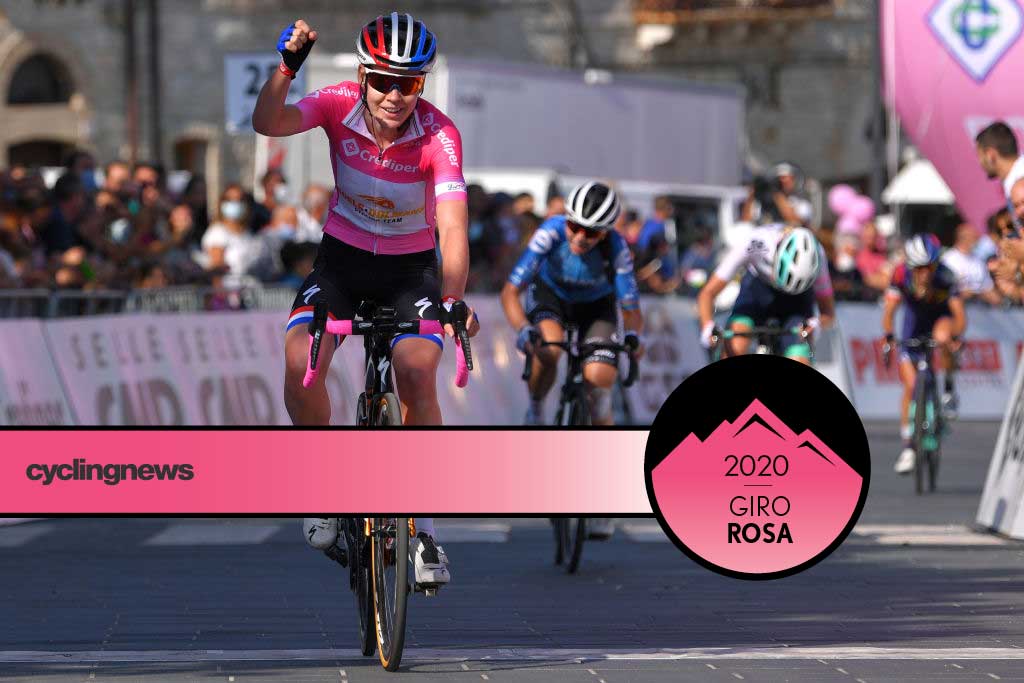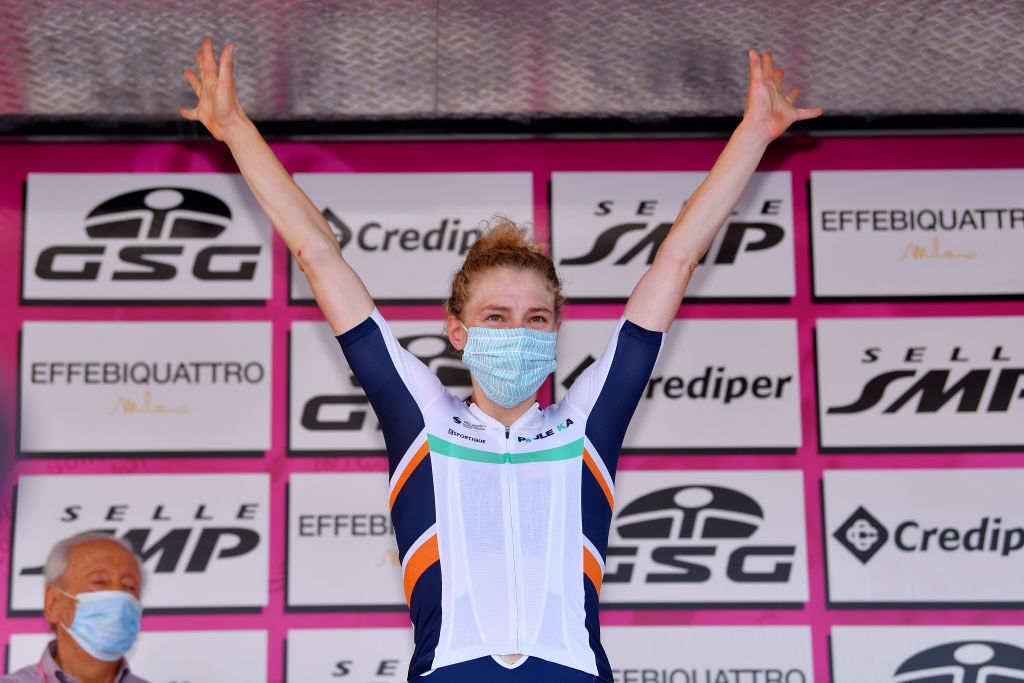Giro Rosa surprised to lose Women’s WorldTour status
Downgrade due to no live TV and organisational concerns

The downgrade of the Giro d’Italia Femminile to a 2.Pro-level stage race comes as a surprise to the organisers, and leaves a gaping hole in the Women’s WorldTour calendar in 2021. The event was originally named to next year’s top-tier calendar earlier this summer, however, the sport governing body bumped it down to the second-tier of events after organisers failed to meet all of the WorldTour requirements, including no live broadcasts of the race during the September 11-19 race.
The organisers of the Giro Rosa have told Cyclingnews that the decision to strip the race of its WorldTour status has caught them off guard. "We, as an organisation, have not received any official communication. For this reason, at the moment, we do not intend to make any statements," a representative from the Giro Rosa organisation told Cyclingnews on Monday.
The UCI announced the 2021 UCI International Calendars, with the approval from the UCI Management Committee, for different disciplines, including the Women's WorldTour, on September 25 during the Road World Championships. The Giro Rosa was marked as a 2.Pro event without an official statement for the downgrade provided by the UCI at that time.
The UCI has since told Cyclingnews that it withdrew the Giro Rosa from the Women's WorldTour due to various shortcomings regarding the organisation of the race.
“The Union Cycliste Internationale (UCI) has withdrawn the Giro Rosa from the UCI Women's WorldTour 2021 due to various shortcomings on the part of the organiser with regard to the specifications (particularly in terms of television coverage), despite repeated requests from us over the past few years. We hope that the Giro Rosa, a historic race on the professional women's road cycling calendar that is highly appreciated by the riders, will do its utmost to reach the level required by the UCI Women's WorldTour," read a statement from the UCI emailed to Cyclingnews.
The Giro Rosa was originally scheduled to take place June 26 to July 5 this year, but was postponed until September as part of the post-COVID-19 revised Women's WorldTour calendar. Organisers were also forced to reduce the event by one day, to nine stages, but the race went ahead in the central-southern regions of Tuscany, Umbria, Lazio, Campania and Puglia.
This year’s event marked the 31st edition and race director Giuseppi Rivolta was determined to make the race go ahead as a symbol of the restart of a nation hit very hard by the COVID-19 pandemic.
Get The Leadout Newsletter
The latest race content, interviews, features, reviews and expert buying guides, direct to your inbox!
"This is why we did not want to abandon the Giro Rosa, we did not want to give up, we fought and made sacrifices so that the magic of the peloton on the roads can be repeated again this year, albeit with a different place on the calendar," Rivolta said in the August route announcement.
Professional cycling fans were able to enjoy complete live coverage packages of the rescheduled Tour de France and Tirreno-Adriatico, but as the Giro Rosa kicked off with the team time trial in Grosseto on September 11, it quickly became apparent that fans around the world would not be able to follow the race because there was no live television broadcast.
Frustration mounted, particularly because organisers that apply to be part of the Women’s WorldTour are required to provide 45 minutes of live television broadcasts each day. This requirement was implemented by the UCI this year to help raise the level of viewership and professionalism of the races and to meet the fast-growing demands of fans interested in watching the top-tier women's cycling on live platforms.
Cyclingnews understands that the organisers of the Giro Rosa committed to the live broadcast in their application and that even the UCI were surprised to learn that no live coverage was offered when the race began. The UCI had confirmed to Cyclingnews ahead of the race that organisers committed to a lesser 20 minutes of programming for TV, scheduled during each stage of the Tour de France, but not even that happened.
In previous years, RAI Sport has provided short live segments of the race during the full footage of the Tour de France, followed by a post-race highlights package. It was announced in March that Pulse Media Group (PMG Sport) reached an agreement with Athletic Sports Group (ASG) for the media rights to the Giro Rosa. ASG confirmed to Cyclingnews on stage 1 that the race would only be offered as a "near-live" post-race programme, but when asked about the required 45 minutes of live television, they did not respond.
The only way of accessing the Giro Rosa was through text play-by-plays offered on social media channels, such as Twitter, from the UCI's main Women's WorldTour account (@UCI_WWT) and the Giro Rosa (@GiroRosaIccrea). There were also a range of post-race broadcasts (delivered "as-live") along with additional video content available on Flobikes, SBS, Eurosport and GCN, but even this content, that was provided by the organisers, was limited and often completely missed the unfolding events of each stage.
"As a rider you're just completely focused on getting a massage and going to bed," said Lizzie Deignan (Trek-Segafredo), who placed twice on this year’s Giro Rosa podium in individual stages and helped her team win the opening team time trial. "You're not aware of the bigger picture. Of course it's just not good enough and it needs to be better, that's kind of an obvious answer for us when we're asked.
“We're not happy, it's not good enough, it has to be better but in those moments when you're in the Giro [racing] you want to be given the same respect, and be able to just focus on the race itself because it was just so intense and so hard. That is the opportunity we're all searching for as athletes - to just focus on the racing aspect."
The organisers hit back at complaints about the lack of live television coverage of this year’s race, claiming the COVID-19 pandemic has forced them to sacrifice live coverage to ensure the race went ahead. They also said that television scheduling was a main concern, with the scheduled line-ups for live broadcasting already at capacity during September. Cyclingnews understands that they were also concerned about extra costs associated with increased expenses of the major WorldTour teams.

Lizzy Banks (Équipe Paule Ka), who won the 170km stage 4 into Tivoli this year along with stage 8 into Maniago last year, spoke with Cyclingnews following the Giro Rosa and called on all stakeholders, including the UCI, to help financially commit to the costs of live broadcasting to ensure that major women’s cycling events reach international audiences.
“If that’s true then, this is where the UCI needs to step in. We need to further women’s cycling but what is the point in racing if it’s not on TV? If the people can’t watch it then there’s no point in having the race in the first place," Banks said.
Cyclingnews understands that the Giro Rosa was not provided a live broadcasting exemption this year and that it does not receive additional funds from the sport governing body to help cover broadcasting fees, nor does any other event.
The Giro Rosa is a long-running women's race with more than 30 years on the calendar. From a historical context, it is the biggest and most prestigious women's race in the world. It is the only women's Grand Tour of the season that, normally, covers 10 days of racing and includes iconic mountain passes such as the Mortirolo, Stelvio, and Zoncolan. However, it has also been one of the toughest of the Women's WorldTour races to follow due to limited live broadcast coverage over the years and complaints of poor organisation are not new.
Cyclingnews understands that concerns extend further than a lack of live programming, and include security and safety, finances, and general race organisation concerns. This year alone, the peloton faced unannounced delays to the starts, and stage 4 started earlier but teams were not notified of the time change. In addition, the stage 6 route changed mid-stage making it slightly shorter, and the stage 3 run-in to the final climb changed. While stage 4's 170km race was celebrated by some, it was also longer than the 160km maximum race distance set by the UCI. There were also reports of safety concerns surrounding traffic.
“We don’t want to lose races like the Giro because it’s such a good race," Banks told Cyclingnews last week, adding to her claim that cycling stakeholders need to come together to help the race improve.
"Yes, the organization is crazy. Yes, the race is crazy, and yes sometimes you end up going down a motorway and into oncoming traffic, but welcome to the Giro! We want to keep this race but we need to help further it and the UCI need to help the organisers, and all the stakeholders need to work together.”
Gaping hole on Women’s WorldTour calendar
The Women’s WorldTour series lost many events due to cancellations during the COVID-19 pandemic this year. The revised calendar retained 12 events (of the original 23) that included two stage races and 10 one-day races, held from August-November.
The UCI had announced 25 events for the 2021 Women’s WorldTour calendar in July, and at that time it included the Giro Rosa, along with the return of this year’s cancelled events. Many of the notable events are returning to their usual spots on the calendar, such as the Spring Classics with Paris-Roubaix that was introduced as part of the revised calendar this year, the six-day Women’s Tour in Great Britain, La Course, Prudential Ride London Classique, the four-day Ladies Tour of Norway and the six-day Boels Ladies Tour, among others.
The Tour of California and Emakumeen Bira will not be returning. The May slot will be filled with two new additions to the calendar - the three-day Itzulia Women (formerly Donostia San Sebastian) and the three-day Vuelta a Burgos Feminas.
The removal of the Giro Rosa now leaves a gap in the Women’s WorldTour calendar during the month of July, even though it is still scheduled to take place from July 2 to 11 as a lower-class stage race.
“It’s the only long stage race on the calendar, and it has a name which is linked to heroic performance, so it’s a pity they [the organisers] didn’t manage to fulfill the requirements. It leaves a gap in the calendar," Ronny Lauke, team manager at Canyon-SRAM told Cyclingnews. "I believe with that [2.Pro] category it won’t even be allowed that all WorldTeams can partake at that race next year."
As a 2.Pro race, organisers are under no obligation to provide live television. In addition, and while team invitation are at the discretion of the organisers, they may not be permitted to invite all Women’s WorldTeams to participate.
There are currently eight WorldTeams, but the aim is to build to a maximum of 15 teams over the next three years. The UCI stipulates that Women's WorldTour events are open to all Women's WorldTeams, and then to Continental Teams, with a total of 15 to 24 participating teams permitted on the start line. The eight WorldTeams receive automatic invitations to the WorldTour events, as do the Continental Teams that are among the top 15 in the world ranking. Next year there are expected to be additional Women’s WorldTeams.
The new ProSeries events are permitted to invite 15-24 teams to participate, but they are only open to a minimum of four and a maximum of 10 Women’s WorldTeams, entirely at their own discretion. This means that if there are more than 10 licensed WorldTeams next year, not all of them will be invited to compete at the Giro Rosa. The remaining spots will go to Women’s Continental Teams, National Teams and a maximum of two regional teams and/or clubs from invited countries.
Cyclingnews understands that the organisers of the Giro Rosa will be permitted to re-apply for WorldTour status in 2022.

Kirsten Frattini is the Deputy Editor of Cyclingnews, overseeing the global racing content plan.
Kirsten has a background in Kinesiology and Health Science. She has been involved in cycling from the community and grassroots level to professional cycling's biggest races, reporting on the WorldTour, Spring Classics, Tours de France, World Championships and Olympic Games.
She began her sports journalism career with Cyclingnews as a North American Correspondent in 2006. In 2018, Kirsten became Women's Editor – overseeing the content strategy, race coverage and growth of women's professional cycling – before becoming Deputy Editor in 2023.